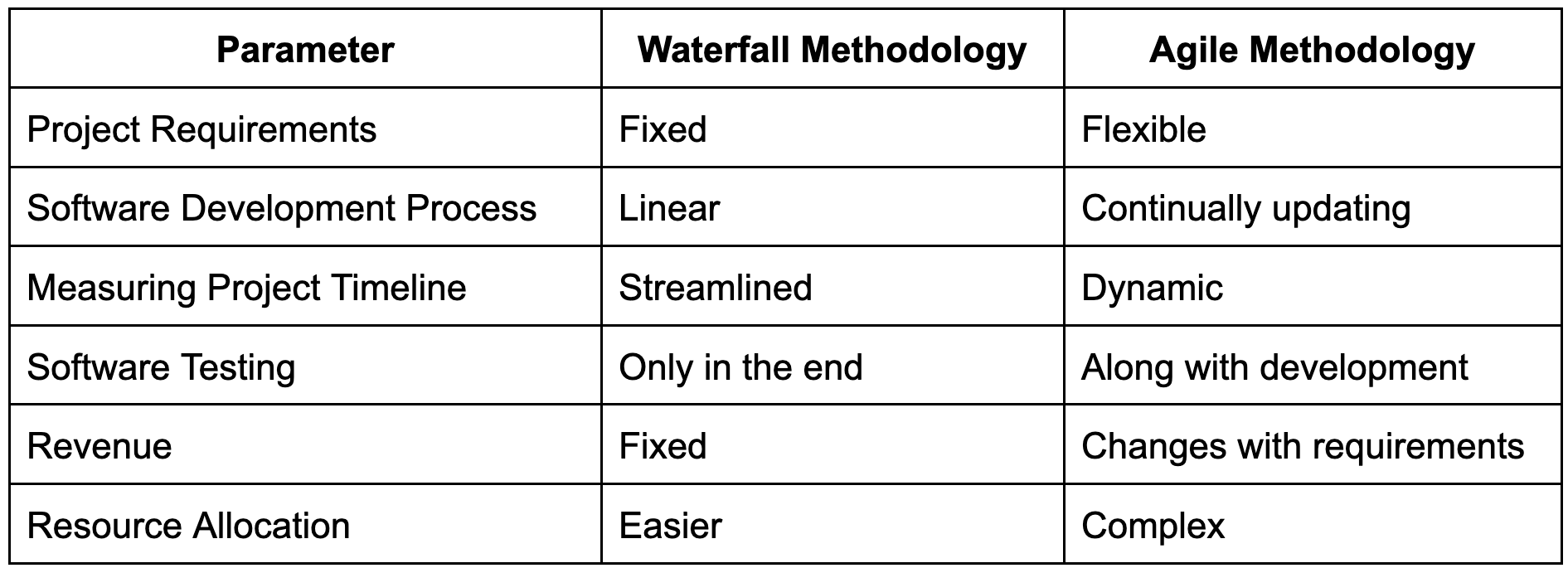Table of Contents
Waterfall vs. Agile Methodology: How Are They Different?
Author

Date

Book a call
Managing a software development project is key to deciding the quality of the result produced. Numerous project management methodologies offer equally essential advantages. Selecting the appropriate model for your project can become difficult.
As per our experience of developing software from scratch, we can say that two of these project management techniques stand out from the rest and are widely adopted by software development companies worldwide. In this article, we will discuss these approaches, the traditional waterfall approach, and the advanced agile methodology in detail.
Let’s begin.
What Is Waterfall Project Management Methodology?
Waterfall project management methodology is an age-old technique that has effectively helped develop and deliver a wide range of software projects. It has been in place for a relatively long time and hence is also referred to as the traditional approach to project management.
We usually use the waterfall approach when the scope of the project and the requirements are fixed and known before starting the project. Both the client and the developers analyze the requirements and plan the development process accordingly. Developers follow a guided and fixed software development life cycle that cannot be changed in the middle.
The various stages of the software development process here include:
- Requirements gathering
- Planning
- Development
- Testing
- Deployment
The waterfall model solely focuses on adhering to the predefined timelines. There is no scope for additional requirements or changes. The role of the project manager is to plan and execute the project from start to finish. They are responsible for the decision-making involved and the successful completion of the project.
What Are The Benefits Of The Waterfall Model In Software Engineering?
Waterfall software development is a pre-planned process that offers many benefits. Going by our many use cases, this model has allowed the developers within the system and the clients to easily keep track of the process at every step. Some of the other benefits include:
- Follows a time-based execution of tasks
- Useful when the requirements of the software solution are fixed
- Easier for developers to provide time and cost estimates
- The timeline for product delivery can be measured easily
- It is easier for organizations to plan and allocate resources according to the requirements
What Are The Disadvantages Of Waterfall Methodology?
As much as it offers the ease of resource planning and follows a fixed timeline, the waterfall methodology also has some drawbacks. Here are some of the disadvantages we faced when following this fixed-requirements model:
- No room for changes in software requirements
- Testing starts only after the development of the whole system
- Unsuitable for developing software that requires updates on the go
What Is Agile Methodology In Project Management?
The agile project management approach is considered an advanced way of software development as compared to the waterfall approach. It allows for software development on the go. Businesses that only have an abstract idea of the web or mobile application that they require can begin the software development process using this approach.
We’ve found Agile to be an iterative development process that allows collaboration between cross-platform teams. Here, the whole process is divided into multiple small tasks which are known as sprints. Each team is accountable for completing their tasks and communicating their learning, development, or hurdles in sprint meetings.
New sprints are planned and allocated to team members after each scrum meeting. Agile software development is a task-based approach and offers enough flexibility for continuous development along with allocating multiple changes.
The team leader here is also known as the scrum master and provides the team with an abstract roadmap of what needs to be done. Other stakeholders are also allowed to make suggestions to the product development team with the final decision-making on the scrum master. The agile approach can change the course of software development as and when required. Clients are allowed to ask for more additions to or subtract already planned tasks.
What Are The Benefits Of Agile In Software Development?
We have adopted agile methodology as an integral part of our software development processes. It has allowed us to employ a self-learning software development life cycle. Our developer teams learn the requirements and implement them on the go. Some of the benefits that best describe our experience with this approach include:
- Allows to accommodate multiple changes in software requirements
- Allows to focus on more tasks and features in a given time
- Possible to test individual components as and when developed
- More streamlined and efficient product development
- The best example of ‘Kaizen’ - continual development
What Are The Disadvantages Of Agile Methodology?
Apart from the endless benefits, we also faced a few cons of agile development during web and mobile app development. Some of these include:
- The project development timeline is fragmented and cannot be ascertained from the beginning
- The cost of the project is not fixed
- Difficult for organizational resource management
What Are The Differences Between Agile And Waterfall?
Based on the above information, we can define the most important differences between waterfall and agile methodologies as follows:

Which Software Development Model To Choose For Your Project?
The choice of the right software development model for your project varies based on the use case. We understand that not every project can be developed in the same way, and there is no textbook project management method that can suit every project. We like to incline ourselves to Agile a tad bit more than the waterfall model, considering the benefits it has provided in the past and how it has helped us deliver countless top-quality projects over the years and make our clients happy. Some of the factors that helped us make the right decisions include:
- Knowing the software requirements.
- Determining the skills required to develop software.
- Figuring out the project delivery timeline requirements.
- Knowing the budgetary constraints.
Conclusion:
Both the waterfall model and the Agile model have their own perks and boundaries, but they both find their appropriate use in their own set of circumstances. We hope that this article helps you understand the right way to evaluate what fits your needs the best and helps you manage your projects better when collaborating with a development agency to build fantastic products.
Dive deep into our research and insights. In our articles and blogs, we explore topics on design, how it relates to development, and impact of various trends to businesses.


